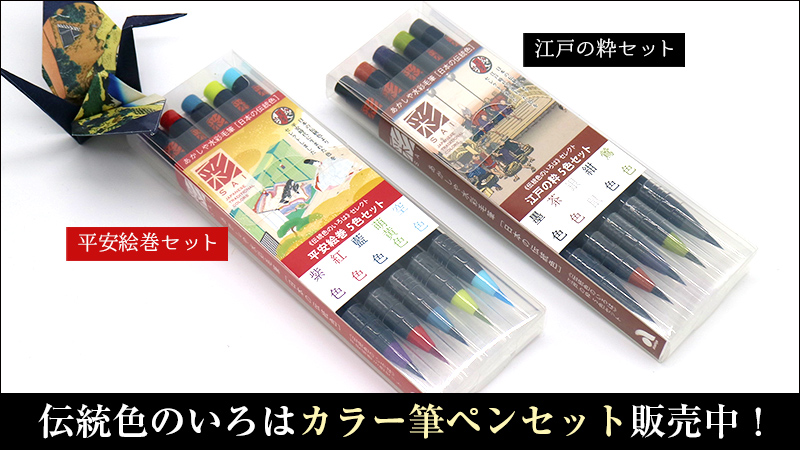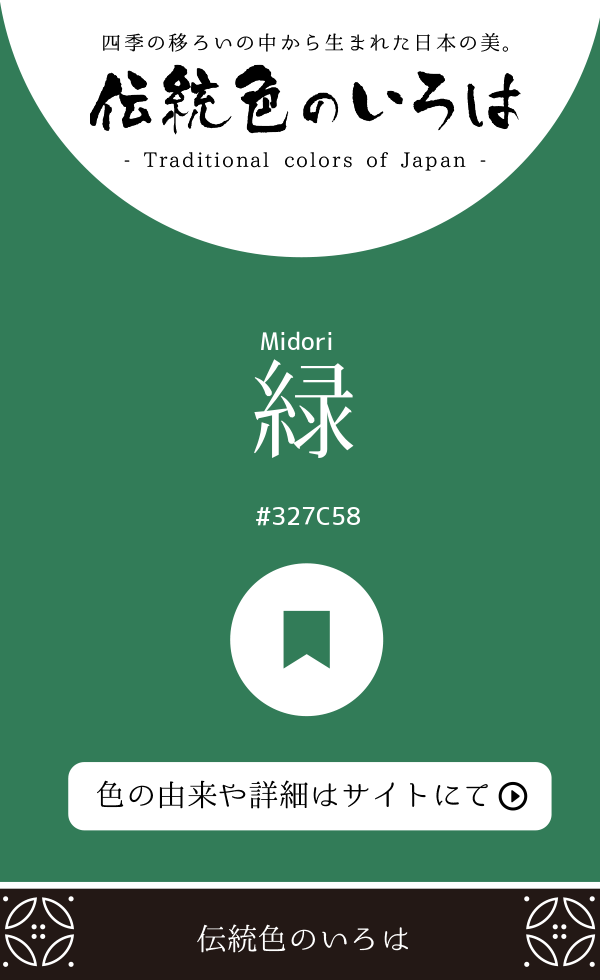| 色の名前Japan Color Name | 緑(みどり) |
|---|---|
| ローマ字Romanized | Midori |
| RGB | R:050 G:124 B:088 |
| CMYK | C:81 M:42 Y:77 K:02 |
| Web カラーHex triplet |
色の説明
緑(みどり)とは、おいしげる樹木の葉の色のような深い緑色のことです。光の三原色の一つ。古代から使われている色名で、古くは露草 による『青』と、刈安 か黄檗 による『黄色』で染めていました。
『緑』の初出は大化三年(六四七)の「七色十三階の官位の制」。
養老の衣服令 (七五七)では『深緑 』と『浅緑 』の2色に分かれており『深緑』が官位六位、『浅緑』が七位と中位の色でした。また 、「延喜縫殿寮式 」には『深緑』『中緑』『浅緑』の3色の染色について記されています。
古くから寒色系統の色は「あお」と呼ばれていましたが、特に深い緑色を指す場合は、鴗鳥 (翡翠 の古名)の羽根の緑色にちなんで「そにどりのあお」と呼んでおり、「みどり」の和名は「そにどり」から転じたものともいわれています。
「鴗鳥 の青き御衣 を ま具 さに 取り装ひ」(古事記)
なお、緑の語源ともいえるカワセミの羽の色ですが、カワセミに由来する『翠色』という色ができたのは明治以降とわりと最近のことでした。
一般的に「緑」といえば、緑系全般の幅広い色合いを指していますが、伝統色的にいえば濃い緑色のことです。ただ、現代のJIS規格で定義された『緑色』ははもう少し鮮やかな色を指しています。
ちなみに、現在でも新緑の葉を「青葉」と呼んだり、田んぼの緑を「青田」と呼ぶなど、緑色を「青」と表す言葉が多数見られますが、これは昔の人が青と緑を区別できなかったわけではなく、言葉として使い分けていなかっただけです。
現代でいえば、『水色』や『空色』と使い分けずにどちらも「青」と呼ぶ感覚に近い感じでしょう。


-読み:みどり-
「蘇邇杼理能(そにどりの)青き御衣」
『古事記』神代、八千矛の神(大国主命)の歌。
「春は燃え夏は緑に紅の綵色(まだら)に見ゆる秋の山かも」
『万葉集』巻十・二一七七。
関連する色の紹介
[Explanation of a color]
The Midori is a deep green color, like the color of the leaves of a delicious tree. It is one of the three primary colors of light. It has been used since ancient times, and in ancient times it was dyed with "blue" from dew grass and "yellow" from Kariyasu or Obaku.
The first appearance of "green" was in the "Seven Colors and Thirteen Stages of Governmental Ranks" in the third year of the Taika era (647).
In the Yoroi Clothing Order Ebukuryo (757), "Fukamidori" and "Asamidori" were divided into two colors: "Fukamidori" was the sixth rank of government rank, and "Asamidori" was the seventh rank, the middle rank color. In addition, the Engi Sewing Hall Dyeing Instructions describe the three colors of "Fukamidori," "Nakamidori," and "Asamidori.
The Japanese name "Midori" is said to be a corruption of "Sonidori." The Japanese name "Midori" is said to be a corruption of "Sonidori.
The Japanese name "Midori" is also said to be a corruption of "Sonidori." "The blue robe of the bird is dressed in makutsuzasa" (Kojiki).
The color of the feathers of the kingfisher, which can be said to be the origin of the word "green," was only recently, after the Meiji period (1868-1912), that the color "Sui-shoku," derived from kingfishers, was created.
The word "green" generally refers to a wide range of shades of green in general, but in traditional terms, it refers to dark green. However, "green" as defined in the modern JIS standard refers to a more vivid color.
Incidentally, even today, there are many words used to describe green as "blue," such as "aoba" for fresh green leaves or "aota" for green rice paddies, but this does not mean that people in the past could not distinguish between blue and green; they just did not use the two different words.
In modern times, it would be similar to the feeling of calling both "blue" without distinguishing between "light blue" and "sky blue.
Translated with www.DeepL.com/Translator (free version)
-read:Midori-
参考書籍
- 長崎盛輝『新版 日本の伝統色 その色名と色調』青幻舎 ISBN-10:4861520711
- 吉岡幸雄『日本の色辞典』紫紅社 ISBN-10:4879405493
- 内田 広由紀『定本 和の色事典』視覚デザイン研究所 ISBN-10:4881082035
注意事項
表示されている色(RGB値)は色の名前に対するおおよそものです。色名によっては広範囲の色を指す場合や文献・書籍等によっては解釈が異なる場合もありますのでご了承ください。 ご利用の環境によっては、色が適切に表示されていない場合があります。
印刷などに伝統色を利用したい場合は、DICグラフィックス株式会社から発売されている日本の伝統色シリーズがオススメです。
Pinterestでシェアする際にご利用ください。
サイト運営者からのお願い
このサイトが気に入った、役に立ったと思われた方は、Amazon・楽天で買い物をする際はぜひ下記のバナーをタップしてからお買い物をお願いいたします。
こちらからお買い物をしていただきますと、価格の1%相当のポイントがサイトに入ります。もちろんその分、高くなるようなことはありません。
いただいたポイントは今後のサイト運営のための書籍代や運営費、モチベーションにつながりますので、ご協力いただけますと嬉しいです。

 DIC 日本の伝統色 第9版
DIC 日本の伝統色 第9版



